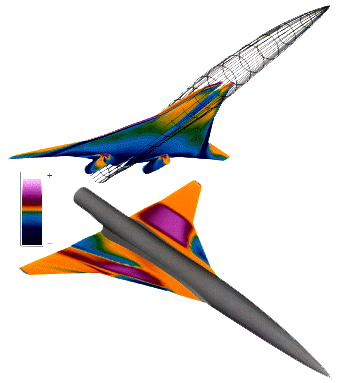 Return to the Table of Contents
Return to the Table of Contents
Objective: To develop and demonstrate aerodynamic optimization methods for use on workstation clusters and scalable parallel architectures. Parallelism at the optimizer and the flow solver levels will be combined to reduce the time required to perform aerodynamic optimization of High Speed Civil Transport (HSCT) aircraft.
Approach: Aerodynamic optimization using Computational Fluid Dynamics (CFD) requires numerous flow solutions, consuming large amounts of computational time. Parallelization at levels appropriate to the computational resources available can accelerate the optimization process. These levels include having the opti mizer compute several solutions at once, or computing the grid zones, and then blocks of points within each zone, in parallel. The objective function (typically lift-to-drag ratio) for all approaches was provided by the OVERFLOW flow solver. Optimization was controlled by either the NPSOL or the IIOWA optimizers. Both optimizers compute gradients of the objective function with respect to several design variables, and iterate toward an optimum. NPSOL provides superior constraint handling, while IIOWA provides superior parallelization.
Accomplishment: Zone and grid level parallelism were used to accelerate the solution of a wing-nacelle-diverter problem on the Intel iPSC/860. This demonstrated the capability of the solver to handle the geometric complexity of a transport aircraft. The same solver was then used with an otherwise serial optimizer on the Intel iPSC/860. Later, a parallel optimizer was used with serial CFD computations on a workstation cluster, achieving nearly 100% parallel efficiency by solving up to 12 independent CFD problems at once.
Significance: The parallel optimization work demonstrates that parallel processing can provide nearly linear speedups when applied to optimization tasks, and can substantially speed up the flow solutions themselves. The wing-nacelle-body work demonstrates the ability of parallel codes to compute flow solutions about increasingly complex configurations. When combined and integrated into the design process, these capabili ties will lead to improved turnaround for supersonic transport optimization and design.
Status/Plans: Flow solvers on several parallel architectures are capable of solving HSCT external aerody namic configurations. Work to find improved algorithms, and to port and optimize current codes, is under way. New optimizers can either use parallelism to accelerate existing methods, or employ new algorithms which may be more efficient for these problems.
Immediate plans include exploitation of parallelism at the optimizer and solver levels on the IBM SP-2. Demonstration of accurate parallel solutions on increasingly complete HSCT configurations will continue. Developments in grid generation will be followed in order to find and adopt methods which can be used inside the optimizer loop.
Point of Contact:
 Return to the Table of Contents
Return to the Table of Contents